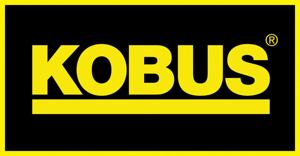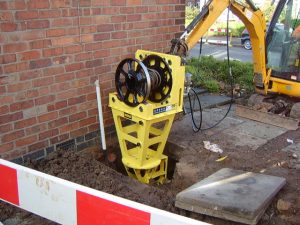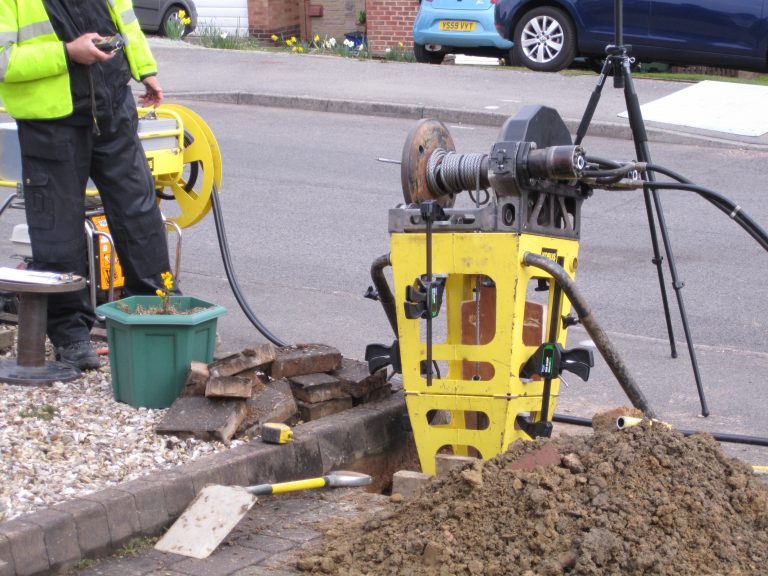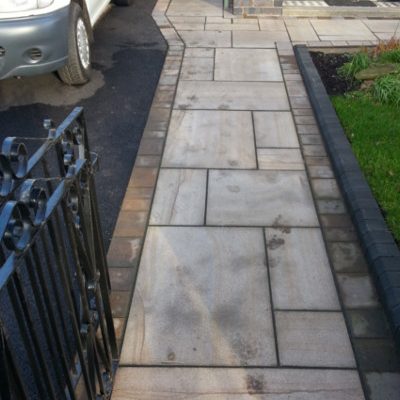In this post we discuss how pipepulling technologies can ensure faster reinstatement of property after a pipe repair. Replacing underground pipes requires some form of excavation. In the UK, it is estimated there are over 4 million excavations dug each year in the management of essential utilities. The extent of excavation depends on the method being employed. Open cut excavation involves digging a trench the full length of the pipe being replaced or renewed. Impact moling and pipe pulling require relatively small excavations at each end of the pipe being replaced, thereby reducing the cost of the backfill materials and reinstatement of the surface. 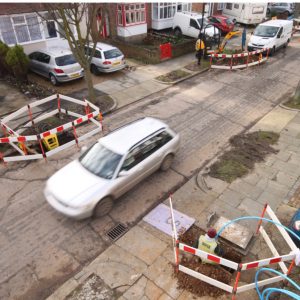 The cost of backfilling the excavations and reinstatement of the ground surface can be expensive. If this is a road crossing, there are regulations about the type of materials that must be used for the backfill and the reinstatement. On private property, the ground needs to be left in a state as closely matching the original condition as possible. Utility companies and contractors regularly receive complaints from homeowners that the reinstatement is not considered adequate and further remedial work is required or compensation paid. Why is this important? Backfilling and reinstatement are essential but non-value adding activities to the replacement of the service. Minimising the costs are therefore a high priority for contractors and utility companies. The cost of reinstatement can be a significant proportion of the overall cost of the job. It is labour intensive, often requiring a second crew to visit the site after the main works have been completed. On a homeowners’ property, the reinstatement is perhaps more problematic. Matching existing driveways and paths for certain materials e.g. tarmac and concrete imprinted driveways is difficult if not impossible. Reducing the extent of any excavation on homeowners’ property is seen as a definite positive. If left unchecked? Costs and resources will continue to escalate. Local authorities are becoming increasingly particular about the quality of reinstatement condition. For example, poor reinstatement in pathways can lead to compensation claims from members of the public who trip and fall on a poorly re-laid surface. Solution Traditional ‘trenchless technologies’, like pipe pulling, are defined as technologies that minimise the need for large excavations. Pipe pulling can reduce the excavation to a hole not much bigger than an A3 sheet of paper (dependent on location and depth of service), so at least any mismatch is kept to a relatively small area. Pipe pulling only requires two small excavations either side of a road. The excavation size is generally governed by the size required to expose the existing pipe and disconnect/reconnect the service rather than the size required to position the puller which typically only requires a 400x400mm square hole.
The cost of backfilling the excavations and reinstatement of the ground surface can be expensive. If this is a road crossing, there are regulations about the type of materials that must be used for the backfill and the reinstatement. On private property, the ground needs to be left in a state as closely matching the original condition as possible. Utility companies and contractors regularly receive complaints from homeowners that the reinstatement is not considered adequate and further remedial work is required or compensation paid. Why is this important? Backfilling and reinstatement are essential but non-value adding activities to the replacement of the service. Minimising the costs are therefore a high priority for contractors and utility companies. The cost of reinstatement can be a significant proportion of the overall cost of the job. It is labour intensive, often requiring a second crew to visit the site after the main works have been completed. On a homeowners’ property, the reinstatement is perhaps more problematic. Matching existing driveways and paths for certain materials e.g. tarmac and concrete imprinted driveways is difficult if not impossible. Reducing the extent of any excavation on homeowners’ property is seen as a definite positive. If left unchecked? Costs and resources will continue to escalate. Local authorities are becoming increasingly particular about the quality of reinstatement condition. For example, poor reinstatement in pathways can lead to compensation claims from members of the public who trip and fall on a poorly re-laid surface. Solution Traditional ‘trenchless technologies’, like pipe pulling, are defined as technologies that minimise the need for large excavations. Pipe pulling can reduce the excavation to a hole not much bigger than an A3 sheet of paper (dependent on location and depth of service), so at least any mismatch is kept to a relatively small area. Pipe pulling only requires two small excavations either side of a road. The excavation size is generally governed by the size required to expose the existing pipe and disconnect/reconnect the service rather than the size required to position the puller which typically only requires a 400x400mm square hole.
 The cost of backfilling the excavations and reinstatement of the ground surface can be expensive. If this is a road crossing, there are regulations about the type of materials that must be used for the backfill and the reinstatement. On private property, the ground needs to be left in a state as closely matching the original condition as possible. Utility companies and contractors regularly receive complaints from homeowners that the reinstatement is not considered adequate and further remedial work is required or compensation paid. Why is this important? Backfilling and reinstatement are essential but non-value adding activities to the replacement of the service. Minimising the costs are therefore a high priority for contractors and utility companies. The cost of reinstatement can be a significant proportion of the overall cost of the job. It is labour intensive, often requiring a second crew to visit the site after the main works have been completed. On a homeowners’ property, the reinstatement is perhaps more problematic. Matching existing driveways and paths for certain materials e.g. tarmac and concrete imprinted driveways is difficult if not impossible. Reducing the extent of any excavation on homeowners’ property is seen as a definite positive. If left unchecked? Costs and resources will continue to escalate. Local authorities are becoming increasingly particular about the quality of reinstatement condition. For example, poor reinstatement in pathways can lead to compensation claims from members of the public who trip and fall on a poorly re-laid surface. Solution Traditional ‘trenchless technologies’, like pipe pulling, are defined as technologies that minimise the need for large excavations. Pipe pulling can reduce the excavation to a hole not much bigger than an A3 sheet of paper (dependent on location and depth of service), so at least any mismatch is kept to a relatively small area. Pipe pulling only requires two small excavations either side of a road. The excavation size is generally governed by the size required to expose the existing pipe and disconnect/reconnect the service rather than the size required to position the puller which typically only requires a 400x400mm square hole.
The cost of backfilling the excavations and reinstatement of the ground surface can be expensive. If this is a road crossing, there are regulations about the type of materials that must be used for the backfill and the reinstatement. On private property, the ground needs to be left in a state as closely matching the original condition as possible. Utility companies and contractors regularly receive complaints from homeowners that the reinstatement is not considered adequate and further remedial work is required or compensation paid. Why is this important? Backfilling and reinstatement are essential but non-value adding activities to the replacement of the service. Minimising the costs are therefore a high priority for contractors and utility companies. The cost of reinstatement can be a significant proportion of the overall cost of the job. It is labour intensive, often requiring a second crew to visit the site after the main works have been completed. On a homeowners’ property, the reinstatement is perhaps more problematic. Matching existing driveways and paths for certain materials e.g. tarmac and concrete imprinted driveways is difficult if not impossible. Reducing the extent of any excavation on homeowners’ property is seen as a definite positive. If left unchecked? Costs and resources will continue to escalate. Local authorities are becoming increasingly particular about the quality of reinstatement condition. For example, poor reinstatement in pathways can lead to compensation claims from members of the public who trip and fall on a poorly re-laid surface. Solution Traditional ‘trenchless technologies’, like pipe pulling, are defined as technologies that minimise the need for large excavations. Pipe pulling can reduce the excavation to a hole not much bigger than an A3 sheet of paper (dependent on location and depth of service), so at least any mismatch is kept to a relatively small area. Pipe pulling only requires two small excavations either side of a road. The excavation size is generally governed by the size required to expose the existing pipe and disconnect/reconnect the service rather than the size required to position the puller which typically only requires a 400x400mm square hole. Guide to challenges facing pipe contractors and how to tackle them
We wrote a whole guide all about the challenges facing contractors in pipe repair and replacement. Be one of the first to download it. If you’re in the business of repairing utility pipes, download our new ground-breaking Ten challenges facing pipe replacement contractors – and how to tackle them more effectively now here.Sign up to receive our FREE essential guide to the ‘Ten challenges facing pipe replacement contractors – and how to tackle them. Click on the ‘Download Guide’ button here
